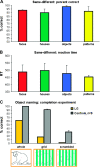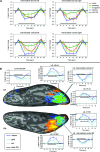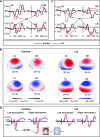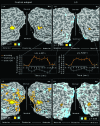Seeing with profoundly deactivated mid-level visual areas: non-hierarchical functioning in the human visual cortex
- PMID: 19015369
- PMCID: PMC2693623
- DOI: 10.1093/cercor/bhn205
Seeing with profoundly deactivated mid-level visual areas: non-hierarchical functioning in the human visual cortex
Abstract
A fundamental concept in visual processing is that activity in high-order object-category distinctive regions (e.g., lateral occipital complex, fusiform face area, middle temporal+) is dependent on bottom-up flow of activity in earlier retinotopic areas (V2, V3, V4) whose main input originates from primary visual cortex (V1). Thus, activity in down stream areas should reflect lower-level inputs. Here we qualify this notion reporting case LG, a rare case of developmental object agnosia and prosopagnosia. In this person, V1 was robustly activated by visual stimuli, yet intermediate areas (V2-V4) were strongly deactivated. Despite this intermediate deactivation, activity in down stream visual areas remained robust, showing selectivity for houses and places, while selectivity for faces and objects was impaired. The extent of impairment evident in functional magnetic resonance imaging and electroencephalography activations was somewhat larger in the left hemisphere. This pattern of brain activity, coupled with fairly adequate everyday visual performance is compatible with models emphasizing the role of nonlinear local "amplification" of neuronal inputs in eliciting activity in ventral and dorsal visual pathways as well as perceptual experience in the human brain. Thus, while the proper functioning of intermediate areas appears essential for specialization in the cortex, daily visual behavior and reading are maintained even with deactivated intermediate visual areas.
Figures








Similar articles
-
Which visual functions depend on intermediate visual regions? Insights from a case of developmental visual form agnosia.Neuropsychologia. 2016 Mar;83:179-191. doi: 10.1016/j.neuropsychologia.2015.07.023. Epub 2015 Jul 21. Neuropsychologia. 2016. PMID: 26209358
-
Structural and functional changes across the visual cortex of a patient with visual form agnosia.J Neurosci. 2013 Jul 31;33(31):12779-91. doi: 10.1523/JNEUROSCI.4853-12.2013. J Neurosci. 2013. PMID: 23904613 Free PMC article.
-
Representation of Maximally Regular Textures in Human Visual Cortex.J Neurosci. 2016 Jan 20;36(3):714-29. doi: 10.1523/JNEUROSCI.2962-15.2016. J Neurosci. 2016. PMID: 26791203 Free PMC article.
-
Human cortical areas underlying the perception of optic flow: brain imaging studies.Int Rev Neurobiol. 2000;44:269-92. doi: 10.1016/s0074-7742(08)60746-1. Int Rev Neurobiol. 2000. PMID: 10605650 Review.
-
Disorders of visual recognition.Semin Neurol. 2000;20(4):479-85. doi: 10.1055/s-2000-13181. Semin Neurol. 2000. PMID: 11149704 Review.
Cited by
-
Unexplained Progressive Visual Field Loss in the Presence of Normal Retinotopic Maps.Front Psychol. 2018 Oct 15;9:1722. doi: 10.3389/fpsyg.2018.01722. eCollection 2018. Front Psychol. 2018. PMID: 30374315 Free PMC article.
-
A Probabilistic Functional Atlas of Human Occipito-Temporal Visual Cortex.Cereb Cortex. 2021 Jan 1;31(1):603-619. doi: 10.1093/cercor/bhaa246. Cereb Cortex. 2021. PMID: 32968767 Free PMC article.
-
Functional outcomes following lesions in visual cortex: Implications for plasticity of high-level vision.Neuropsychologia. 2017 Oct;105:197-214. doi: 10.1016/j.neuropsychologia.2017.06.030. Epub 2017 Jun 29. Neuropsychologia. 2017. PMID: 28668576 Free PMC article. Review.
-
Evaluating functional localizers: the case of the FFA.Neuroimage. 2010 Mar;50(1):56-71. doi: 10.1016/j.neuroimage.2009.12.024. Epub 2009 Dec 16. Neuroimage. 2010. PMID: 20025980 Free PMC article. Review.
-
Normal form from biological motion despite impaired ventral stream function.Neuropsychologia. 2011 Apr;49(5):1033-1043. doi: 10.1016/j.neuropsychologia.2011.01.009. Epub 2011 Jan 13. Neuropsychologia. 2011. PMID: 21237181 Free PMC article.

